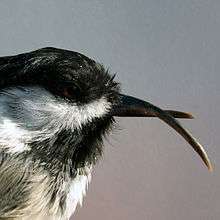Avian keratin disorder

Avian keratin disorder (AKD) is an emerging disease among wild birds in North America characterized by overgrowth and deformities of beaks. Cases were first observed among black-capped chickadees in Alaska in the late 1990s, and it has spread rapidly since then.[1] The cause of AKD is unknown, but may be Poecivirus, a prospective new species of virus within the family Picornaviridae.[1]
Symptoms
In AKD, accelerated growth of the keratinized outer layer of the beak (the rhamphotheca)[2] causes elongation and crossing of the mandibles of the beak.[1] This is debilitating and often deadly, as it obstructs the birds' ability to feed and preen themselves, with the resulting dirty and matted plumage unable to play its role in thermoregulation.[3]
One potential secondary symptom is the formation of lesions on various other keratinized tissues. Areas affected include the skin, legs, feet, claws, and feathers. Since AKD is not yet well understood, it has not been determined whether these lesions are strictly a secondary symptom or part of a systemic disorder.[3]
Prevalence
Initially, AKD was reported in only two species of Alaskan bird, the tree sparrow and a single specimen of the white-winged crossbill.[4][5] While overgrown and crossed beaks have been identified in upwards of 30 species within Alaska alone, many of those have had only a handful of individuals affected. Other than black-capped chickadees, the species most affected are various corvids, nuthatches, and woodpeckers. In addition, surveys of Northwestern and American crow populations have indicated the possibility of regional clusters of AKD.[6]
References
- 1 2 3 Zylberberg, Maxine; Van Hemert, Caroline; Dumbacher, John P.; Handel, Colleen M.; Tihan, Tarik; DeRisi, Joseph L. (26 July 2016). "Novel Picornavirus Associated with Avian Keratin Disorder in Alaskan Birds". mBio. 7 (4). doi:10.1128/mBio.00874-16. PMC 4958255. PMID 27460795.
- ↑ Van Hemert, Caroline; Handel, Colleen M.; O’Hara, Todd M. (July 2012). "Evidence of accelerated beak growth associated with avian keratin disorder in black-capped chickadees (Poecile atricapillus)". Journal of Wildlife Disease. 48 (3). doi:10.7589/0090-3558-48.3.686. PMID 22740534.
- 1 2 Handel, Colleen M.; Pajot, Lisa M.; Matsuoka, Steven M.; Van Hemert, Caroline; Terenzi, John; Talbot, Sandra L.; Mulcahy, Daniel M.; Meteyer, Carol U.; Trust, Kimberly A. (October 2010). "Epizootic of Beak Deformities Among Wild Birds in Alaska: An Emerging Disease in North America?". The Auk. 127 (4). doi:10.1525/auk.2010.10111.
- ↑ West, George C. (October 1959). "Effects of High Air Temperature on the Bill and Claw Keratin Structures of the Tree Sparrow". The Auk. 76 (4). doi:10.2307/4082330. JSTOR 4082330.
- ↑ West, George C. (July 1974). "Abnormal Bill of a White-Winged Crossbill". The Auk. 91 (3). doi:10.2307/4084484. JSTOR 4084484.
- ↑ Van Hemert, Caroline; Handel, Colleen M. (October 2010). "Beak deformities in Northwestern Crows: evidence of a multispecies epizootic". The Auk. 127 (4). doi:10.1525/auk.2010.10132. JSTOR 10.1525/auk.2010.10132.
